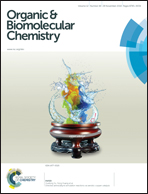A straightforward modification in the thrombin binding aptamer improving the stability, affinity to thrombin and nuclease resistance†
Abstract
Degradation of nucleic acids in biological environments is the major drawback of the therapeutic use of aptamers. Among the approaches used to circumvent this negative aspect, the introduction of 3′–3′ inversion of polarity sites at the sequence 3′-end has successfully been proposed. However, the introduction of inversion of polarity at the ends of the sequence has never been exploited for G-quadruplex forming aptamers. In this communication we describe CD, UV, electrophoretic and biochemical investigations concerning thrombin binding aptamer analogues containing one or two inversions of polarity sites at the oligonucleotide ends. Data indicate that, in some cases, this straightforward chemical modification is able to improve, at the same time, the thermal stability, affinity to thrombin and nuclease resistance in biological environments, thus suggesting its general application as a post-SELEX modification also for other therapeutically promising aptamers adopting G-quadruplex structures.


 Please wait while we load your content...
Please wait while we load your content...